
Washington State is a great location for saltwater fishing. One of the best fish to look for in Washington is the striped marlin. They are large and strong swimming fish, perfect for anglers who want a challenge. Are you interested in the state’s record? Follow along to discover the largest striped marlin ever caught in Washington and the world.
Discover the Largest Striped Marlin Ever Caught in Washington
The largest striped marlin ever caught in Washington weighed an astonishing 134 pounds. Phil Wolff caught this impressive fish in 2005 in Westport. Wolff reeled in this heavy catch about 40 miles out of Westport. According to the state record-holding angler, it took nearly 45 minutes to catch the fast fish. Phil Wolff has held this record for almost two decades.
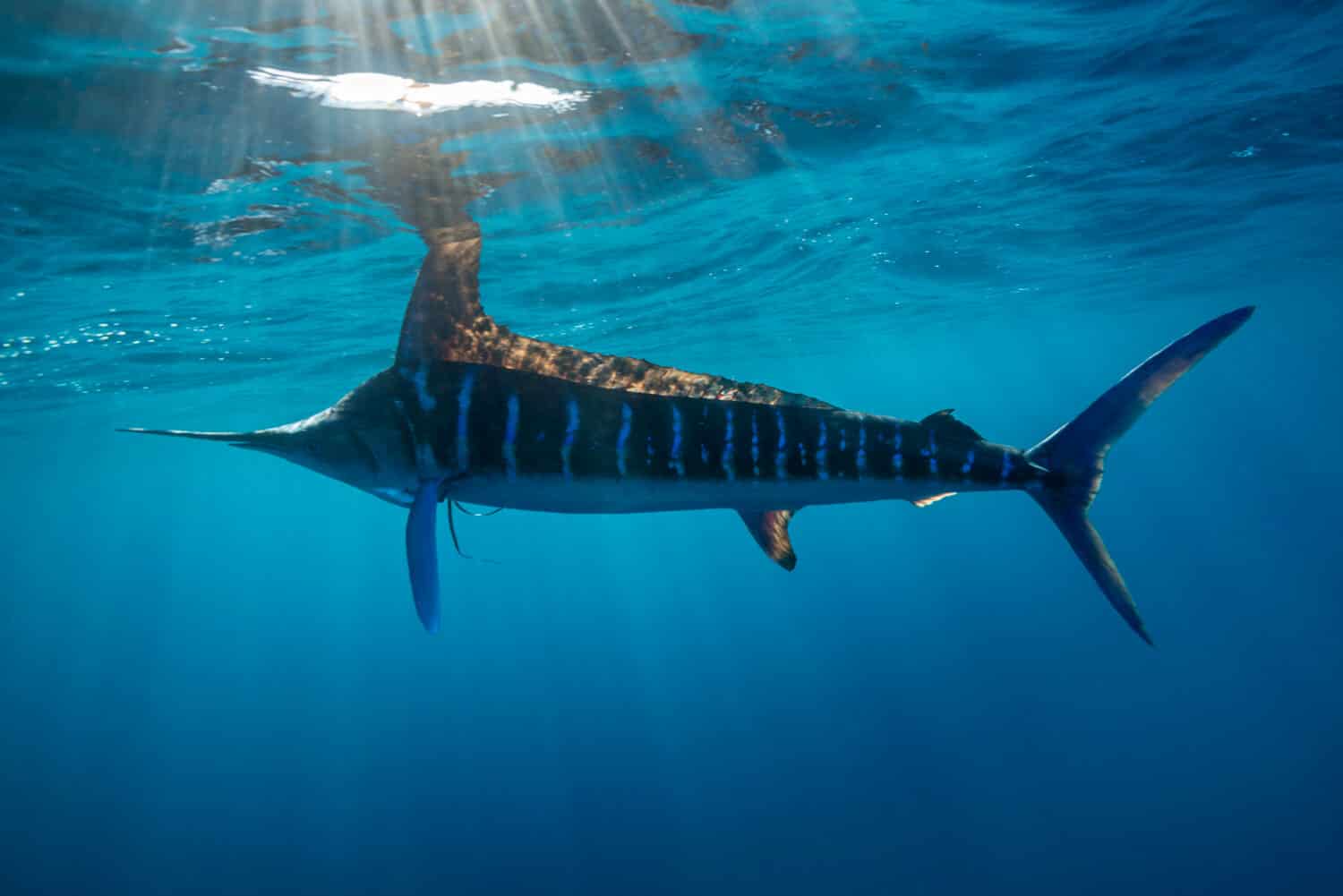
On September 2, 2005, Phil Wolff caught a 134-pound striped marlin, the state’s largest catch.
©wildestanimal/Shutterstock.com
About Striped Marlin
Striped marlins are unique and extraordinary fish. They are fast and strong swimmers that live up to about 10 years. The scientific name for a striped marlin is Kajikia audax. Currently, this marlin species is listed as the Least Concern on the IUCN Red List. Although considered Least Concern, striped marlin are at-risk for overfishing.
Appearance and Size
Striped marlins are easy to identify and distinguish from other marlins. They have distinct dark blue stripes on their bodies. Striped marlins have torpedo-shaped bodies and a long and slender bill. They use this bill to hunt and defend themselves from predators.
Striped marlins range in size. However, on average, they are about 9.5 feet long. Although most striped marlin only reaches 9.5 feet long, larger marlin have been recorded as long as 13.5 feet.
Habitat and Distribution
So, where do striped marlins live? Striped marlins live in the North Pacific. They have a wide range. You can mainly find these fish near the surface of the water at depths up to 300 feet. Striped marlins also live in relatively warm waters.
Diet
These top predators aren’t afraid to hunt large fish, squid, and crustaceans. They’ve been recorded eating tuna and sardines. These opportunistic feeders use their long bills to hunt for food.
Predators
Striped marlins have few predators. There aren’t a lot of animals that are willing to try and attack another large animal. Striped marlins are also great at defending themselves. They use their bill to fight back. Humans are the main predators of striped marlins. Although these fish are protected in the United States.
The Largest Striped Marlin Ever Caught in the World
The largest striped marlin ever caught in the world is nearly four times as large as Washington’s state record. On January 16, 1986, Bill Boniface caught a giant 494-pound striped marlin in Tutukaka, New Zealand. No one has gotten close to beating this record. The fish was 115.67 inches long with a 57-inch girth. This once-in-a-lifetime catch is unrivaled, although other marlin species are larger. The largest marlin ever caught in the world was a black marlin. It was 14 feet and 6 inches long and weighed a back-breaking 1,560 pounds. The girth of this sea monster was 6 feet and 9 inches. It was caught in 1953. It took almost 2 hours for Alfred Gladwell, Jr. to catch this beast.
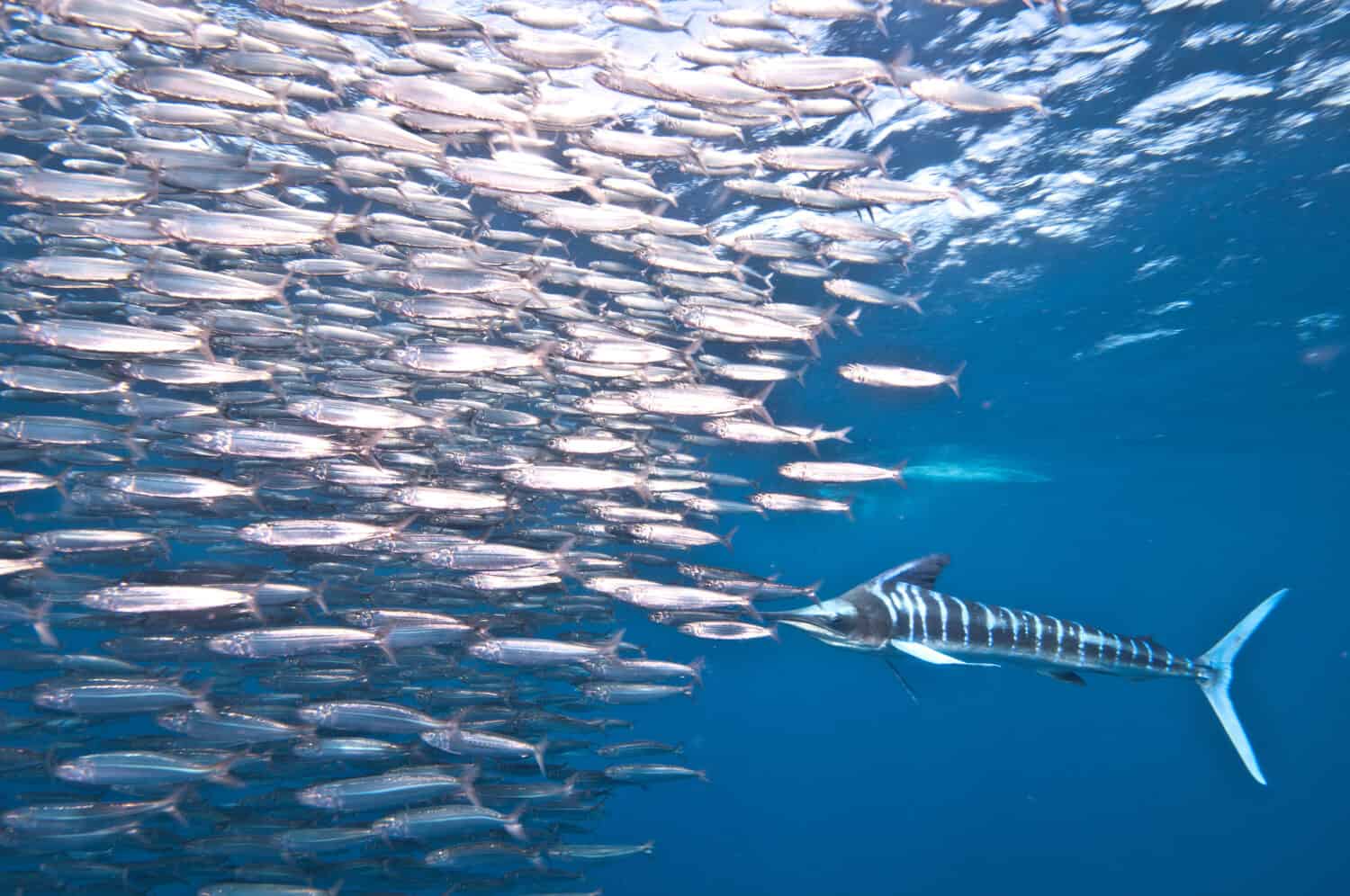
The largest striped marlin ever caught in the world weighed 494 pounds.
©Image Source Trading Ltd/Shutterstock.com
Other Fish in Washington State
Now that we’ve discovered the largest striped marlin ever caught in Washington, we can discuss other native fish species. Washington State has no shortage of fish. Although you can try your luck at catching a striped marlin, you can also look for trout, bass, and salmon. Maybe you’ll even catch a new state or world record! Continue reading to discover other fish you can catch in Washington’s waters.
Blue Rockfish
The first fish on our list is the blue rockfish. This vibrant marine fish is also known as blue seaperch. It’s a member of the family Scorpaenidae and is native to the northeastern Pacific Ocean. As their name suggests, blue rockfish are smooth with bluish-gray coloration. They also have darker mottling which helps them hide from predators. Blue rockfish are small, they mainly eat plankton and small jellyfish. Most blue rockfish live near the surface. So, how big can they get? In 2011, Chris McMillin caught a 4.84-pound blue rockfish in Westport. This is impressive considering most blue rockfish only reach about 3.9 pounds.

Blue rockfish are members of the family Scorpaenidae.
©Colin Woods/Shutterstock.com
Largemouth Bass
Another common fish in Washington State is the largemouth bass. These fish go by many names including black bass, bucketmouth, green bass, and green trout. Largemouth bass are a favorite for many anglers as they reach impressive lengths and weights. They are also known as a challenge as they put up a fight when caught. Largemouth bass range in size though. In some lakes, they are only about 1 to 5 pounds, however, the maximum recorded largemouth bass weighed 22.5 pounds. The largest largemouth bass ever caught in Washington was about half of this weight. On August 8, 2016, Bill Evans caught a 12.53-pound largemouth bass in Lake Bosworth.
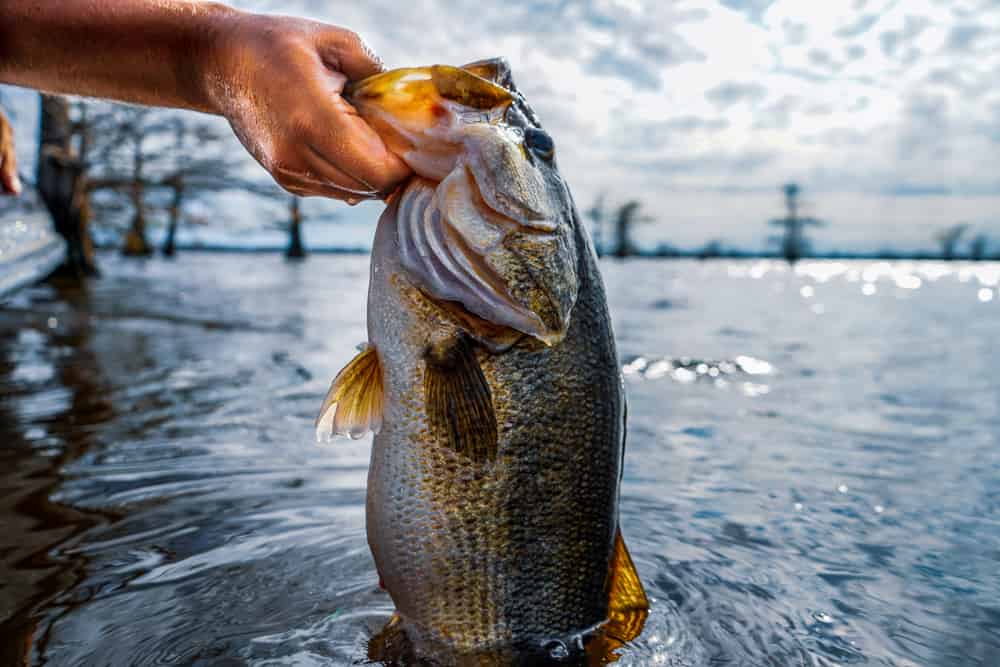
Largemouth bass vary in length and weight.
©Maclane Parker/Shutterstock.com
Steelhead Trout
Steelhead trout are also common fish in Washington. These vibrant fish are also called steelhead salmon. They have silvery bodies with a distinct pink-red stripe. They vary in size and color depending on their environment. Interestingly, there are two state records in Washington. For example, the largest summer-run steelhead trout weighed 35.06 pounds. Gilbert Pierson caught this massive trout in 1973 in Snake River. The largest winter-run steelhead trout though weighed 32.75 pounds. Gene Maygra caught this winter-run fish in 1980 in EF Lewis River.
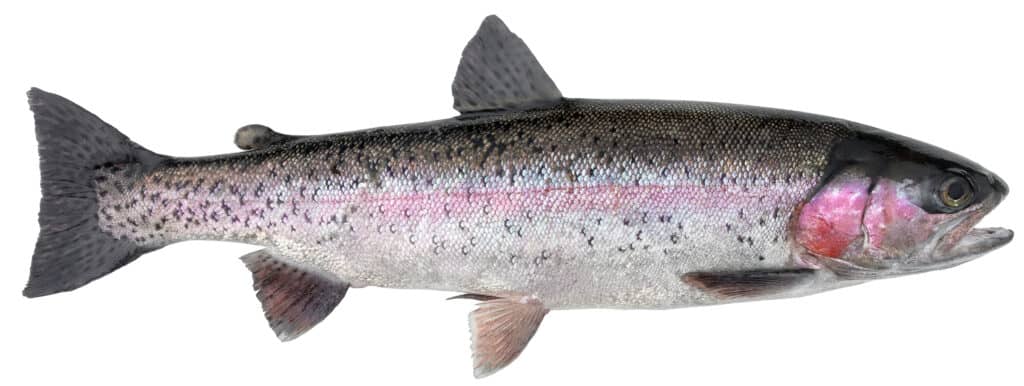
Steelhead trout have long, silvery bodies with a pink or red stripe running on their sides and black speckles
©Edvard Ellric/Shutterstock.com
Sockeye Salmon
Another wonderful fish abundant in Washington is the prized sockeye salmon. Although striped marlins are popular, anglers from throughout the United States travel to Washington and other Pacific Northwest states in hopes of catching a large and bright sockeye salmon. These salmon turn vibrant red-pink during spawning. Mature sockeye salmon weigh between 5 and 15 pounds. They can also grow up to 2 feet and 9 inches long. The Washington record for the largest sockeye salmon is 10.63 pounds. Gary Krasselt has held this record since 1982 when he caught this impressive salmon in Lake Washington.

Sockeye salmon can weigh up to about 15 pounds.
©Vasik Olga/Shutterstock.com
Chinook Salmon
Another salmon species to make our list is the Chinook salmon. Unlike sockeye salmon, Chinook salmon aren’t as vibrant. They are long blue-green, brown, and purple-grey fish with some spotting on their backs. They also have silver tails with black spots. These large Pacific salmon are about 24 to 36 inches long and can weigh up to 130 pounds. Chinook salmon are large Pacific salmon found in the northern Pacific Ocean from California to Alaska. These mighty fish though have been introduced to other states and bodies of water including the Great Lakes. You can also find Chinook salmon in New Zealand. In Washington, the largest Chinook salmon ever caught weighed 68.26 pounds. Mark Salmon caught this giant on October 5, 1992, in the Elochoman River.
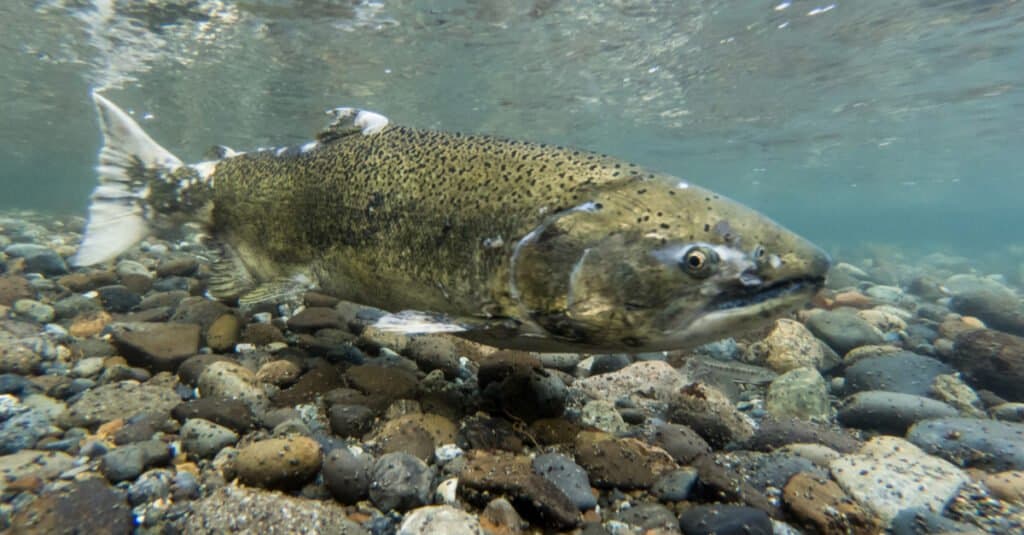
Chinook salmon are large and long Pacific salmon. They can weigh up to 130 pounds and are easily 3 feet long.
©Kevin Cass/Shutterstock.com
Walleye Pollock
Last but not least is the walleye pollock, also known as the Alaskan pollock. The walleye pollock is a small common marine fish found throughout the northern Pacific Ocean. They are especially common in the eastern Bering Sea. Walleye pollock have silverish bodies with black speckled coloration. This helps them hide from predators by blending into the sandy ocean floor. Walleye pollock are small, but important fish. They are commonly caught and eaten as fillets.
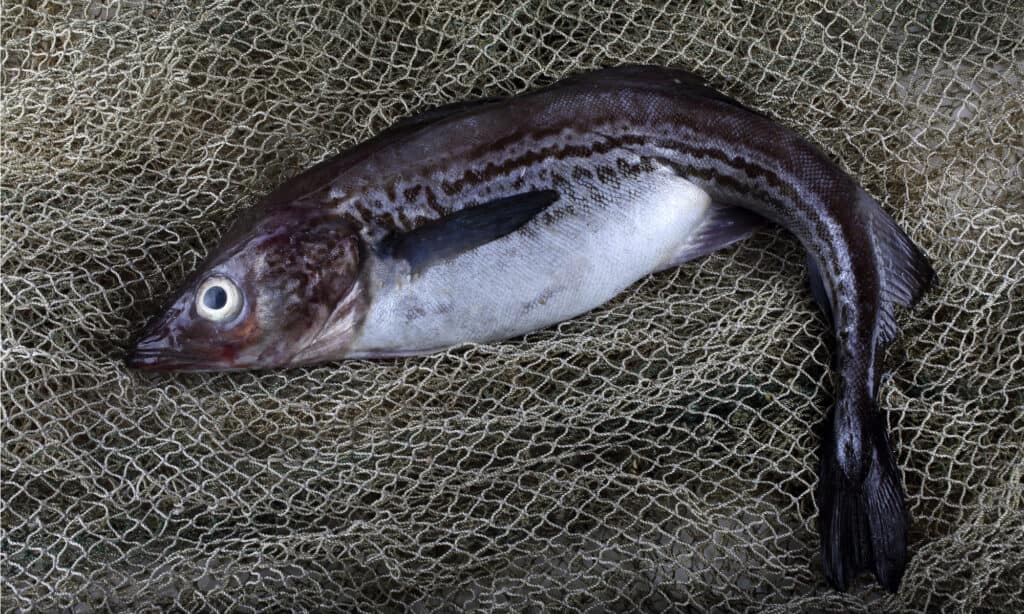
Alaska pollock are also known as walleye pollock.
©Alex Coan/Shutterstock.com
The photo featured at the top of this post is © Earth theater/Shutterstock.com
Thank you for reading! Have some feedback for us? Contact the AZ Animals editorial team.







